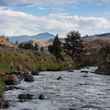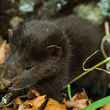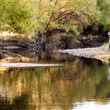I’m not much of a list guy. I’ve just never been one to jot things down. The average trip to the grocery store is generally an adventure in random wandering that depends on me encountering visual clues to what’s needed to fill empty shelves at home.
But when it comes to fly fishing high-elevation trout water, I do, indeed, have my lists. They aren’t written down, per se. They live in the fishy part of my brain, where their compilations now consist largely of instinct rather than recall or reference.
Gear can be somewhat universal for trout, albeit with subtle changes for line weight and such. But flies for the willow-lined creeks of my eastern Idaho mountains? They’re going to be different from the flies I’ll tie and pack for a drift-boat float of the Henry’s Fork.
And dry flies? This is where it gets fun.

The Black Ant
As summer progresses in the mountains, terrestrial bugs become more important components in a trout’s diet. Ants are among the first terrestrial bugs to make an appearance in the high country, and, as such, ant patterns can be fished effectively for most of the summer, including as “indicators” for subsurface nymphs early in the year when waters levels are higher.
I like to tie foam versions of ants in sizes 12 to 14. I use three simple ingredients: A thin strip of black closed-cell foam, an orange tag (also closed-cell foam) and a couple of wraps of dry-fly hackle. That’s it. It’s quick at the vise, easy to see on the water and it floats well enough to support a dropper, should the need arise.

The Stimulator
The origin of this pattern is often in doubt, but Jim Slattery claims to have tied the first Stimulator in 1980 to fish the stonefly hatch on central New Jersey’s Musconetcong River. Here in the West, the “Stimmie” can be tied in different sizes and colors to imitate early-season golden stones, or bigger salmon flies that start to pop anywhere from the end of May through early July, depending on the river drainage.
In the high country, Stimulators tied in sizes 10 to 12 do, indeed, imitate golden stones early in the year, but later in the year, as grasshoppers emerge, these dry flies do a serviceable job as well, particularly if a pair or rubber legs are added in at the vise to give the fly a bit of a wiggle in the surface film. Backcountry cutthroats in search of big bites of protein love Stimmies, and they’ll even hit these patterns fished on the skate. Chasing sometimes-naive high-elevation trout with Stimulators is a visual pursuit — it doesn’t get much more fun.
My favorite Stimulator pattern is tied by Matt Callies, who ties a lot for Loon Outdoors and incorporates some materials in his pattern that some might consider odd, like goose biot feathers for the tail and gold tinsel for the body.

Wullfs
Royal Wulffs, Lime Wulffs, White Wulffs … you name it, somebody’s probably tried it. I’ve even seen all-black Wulff patterns that likely do a better job imitating ants than any other bug that might find its way to the water. Wulff patterns are big, fluffy and usually colorful, and they all feature peacock herl as their main ingredient. The floss at the center of the fly may change colors. Wing material may be debatable, as might the tail material. But the body is, and always should be, tied of iridescent peacock herl.
Tied as pure attractors — they really don’t resemble anything in particular, but rather consist of lots of buggy features that make them an impressionistic offering to wild, gullible trout — Wulffs are tied to float well and last a long time. First tied in the late 1920s by Q.L. Quackenbush and named for angling legend Lee Wulff, the Royal Wulff as undergone some subtle changes over the years, and many anglers tend to be somewhat laissez faire at the vise when it comes to materials (save, of course, for the use of floss and, of course, the peacock herl). I’m partial to Lime Wulffs because I can see them better, and I like to use calf tail for the wings rather than artificial materials, like Antron.

Parachute Hopper
Really, any mid-sized grasshopper imitation will work once high summer is upon us here in the Rockies. But, for the sake of durability and “floatability,” I tend to tie a parachute hopper using a wrapped foam body and rubber legs. Starting in late July and lasting sometimes into October (last fall, I saw grasshoppers on the banks of the Firehole after a below-zero freeze), trout will go out of their way to chase hoppers. In tough environments, these hardy terrestrials offer up a big bite of food, and fish in high-mountain waters don’t often pass them up. Tied in sizes 8 to 12, hoppers are excellent all-day searching patterns for small-stream trout in high-elevation environments. They’re also likely among the most fun to fish, simply because the takes are so visual.

The Adams
Say what you will about the “ho-hum” nature of this somewhat generic mayfly pattern first crafted on the banks of Michigan’s Boardman River by Leonard Halladay in 1922 for attorney Charles F. Adams. But this fly is perhaps the most dependable dry-fly pattern ever tied. That's why you'll find it on so many anglers' list of must-have flies (like this one). In Michigan, the Adams was likely tied to imitate the prolific March Brown and Hexagenia hatches of the region. In the West, I would argue that a size 14 Adams could get just about any dry-fly enthusiast through an entire summer of backcountry angling. Size it up or down, and you could conceivably use an Adams to cover spring and fall Blue-winged Olive hatches, too.
In June and early July, it’s a serviceable Green Drake. Later in the summer, it’s not a bad PMD imitation. It’s versatile, easy to tie, easy to see on the water and, of course, it looks very buggy to backcountry trout that live in austere environments and must be opportunistic feeders.
To make the pattern even more versatile, it’s easy to tie in both crippled and parachute versions.
Honorable mention
No backcountry trout angler’s fly box would be complete without a good, old Elk-hair Caddis collection, no matter what Tom Rosenbauer might say about mature caddis patterns and how big trout might pass them up in favor of emerging bugs that are easier targets. On high-elevation, short-season trout streams, any buggy looking fly pattern is going to get a look, and caddis patterns are visible and float well.
Consider, too, that a lot of mayfly patterns are branches off the same trunk. Just as the Adams is a generic attractor, a Purple Haze might make the backcountry fly pattern cut, simply because of its silhouette on the water. And ants and hoppers aren’t the only “terrestrial” bugs that trout will eat. Wasps and bumble bees also end up in the water on occasion, so perhaps a half-dozen Rainy’s Bumble Bees in size 10 or 12 would be a good addition, particularly in late June and July when wildflowers are painting streamside slopes in the mountains. And don’t forget beetles, either.
From early to mid-summer, I always have a few quill-bodied mosquito patterns on hand. I know if I’m getting eaten alive, these bugs are around, and they are very likely being eaten themselves by trout.
The nice thing about backcountry fly fishing is the simplicity. With a handful of proven flies, just about any astute angler can enjoy a great day on the water without having to think too hard or worry about the sheer volume of flies other anglers are casting over the trout they’re after. Making the effort to get into the backcountry is often the most challenging part of small-stream angling in the Rockies. That’s why it’s also some of the best fishing to be had.





























Comments
doug balfour replied on Permalink
Great list. When I first saw the title, I thought Royal Wulff, Parachute Adams, and Elk Hair Caddis.
Daryl Desabrais replied on Permalink
I have taken up the fishing sport Have been gearing up for a few years.while I can afford to buy the gear I will need like the big ticket items
(Truck,tent boat's Jon boat, Fishing kayak,fish finder.merk out board, waiter's fly rods and reels)
But alot to learn about techniques and patterns I read this hatch forums .Very informative looking
Forward to my retirement plan And many more articles.thankyou for me and I'm sure many others.
Pages